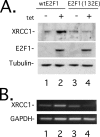E2F1 regulates the base excision repair gene XRCC1 and promotes DNA repair
- PMID: 18348985
- PMCID: PMC2397471
- DOI: 10.1074/jbc.M710296200
E2F1 regulates the base excision repair gene XRCC1 and promotes DNA repair
Abstract
The E2F1 transcription factor activates S-phase-promoting genes, mediates apoptosis, and stimulates DNA repair through incompletely understood mechanisms. XRCC1 (x-ray repair cross-complementing group 1) protein is important for efficient single strand break/base excision repair. Although both damage and proliferative signals increase XRCC1 levels, the mechanisms regulating XRCC1 transcription remain unclear. To study these upstream mechanisms, the XRCC1 promoter was cloned into a luciferase reporter. Ectopic expression of wild-type E2F1, but not an inactive mutant E2F1(132E), activated the XRCC1 promoter-luciferase reporter, and deletion of predicted E2F1 binding sites in the promoter attenuated E2F1-induced activation. Endogenous XRCC1 expression increased in cells conditionally expressing wild-type, but not mutant E2F1, and methyl methanesulfonate-induced DNA damage stimulated XRCC1 expression in E2F1(+/+) but not E2F1(-/-) mouse embryo fibroblasts (MEFs). Additionally, E2F1(-/-) MEFs displayed attenuated DNA repair after methyl methanesulfonate-induced damage compared with E2F1(+/+) MEFs. Moreover, Chinese hamster ovary cells with mutant XRCC1 (EM9) were more sensitive to E2F1-induced apoptosis compared with Chinese hamster ovary cells with wild-type XRCC1 (AA8). These results provide new mechanistic insight into the role of the E2F pathway in maintaining genomic stability.
Figures






Similar articles
-
E2F1 is involved in DNA single-strand break repair through cell-cycle-dependent upregulation of XRCC1 expression.DNA Repair (Amst). 2011 Sep 5;10(9):926-33. doi: 10.1016/j.dnarep.2011.05.006. Epub 2011 Jul 16. DNA Repair (Amst). 2011. PMID: 21757407
-
The role of the retinoblastoma/E2F1 tumor suppressor pathway in the lesion recognition step of nucleotide excision repair.DNA Repair (Amst). 2009 Jul 4;8(7):795-802. doi: 10.1016/j.dnarep.2009.03.003. Epub 2009 Apr 18. DNA Repair (Amst). 2009. PMID: 19376752 Free PMC article.
-
Polβ/XRCC1 heterodimerization dictates DNA damage recognition and basal Polβ protein levels without interfering with mouse viability or fertility.DNA Repair (Amst). 2023 Mar;123:103452. doi: 10.1016/j.dnarep.2023.103452. Epub 2023 Jan 20. DNA Repair (Amst). 2023. PMID: 36702010 Free PMC article.
-
Impact of DNA polymorphisms in key DNA base excision repair proteins on cancer risk.Hum Exp Toxicol. 2012 Oct;31(10):981-1005. doi: 10.1177/0960327112444476. Epub 2012 Sep 27. Hum Exp Toxicol. 2012. PMID: 23023028 Free PMC article.
-
The XRCC1 Arg194Trp polymorphism was associated with the risk of head and neck squamous cell carcinoma development: Results from a systematic review and meta-analysis.Cancer Rep (Hoboken). 2023 Mar;6(3):e1776. doi: 10.1002/cnr2.1776. Epub 2022 Dec 27. Cancer Rep (Hoboken). 2023. PMID: 36573562 Free PMC article.
Cited by
-
DNA repair in cancer: emerging targets for personalized therapy.Cancer Manag Res. 2014 Feb 19;6:77-92. doi: 10.2147/CMAR.S50497. eCollection 2014. Cancer Manag Res. 2014. PMID: 24600246 Free PMC article. Review.
-
Association between the XRCC1 Arg194Trp polymorphism and risk of cancer: evidence from 201 case-control studies.Tumour Biol. 2014 Nov;35(11):10677-97. doi: 10.1007/s13277-014-2326-x. Epub 2014 Jul 27. Tumour Biol. 2014. PMID: 25064613
-
Activated STAT3 Is a Novel Regulator of the XRCC1 Promoter and Selectively Increases XRCC1 Protein Levels in Triple Negative Breast Cancer.Int J Mol Sci. 2021 May 22;22(11):5475. doi: 10.3390/ijms22115475. Int J Mol Sci. 2021. PMID: 34067421 Free PMC article.
-
JWA regulates XRCC1 and functions as a novel base excision repair protein in oxidative-stress-induced DNA single-strand breaks.Nucleic Acids Res. 2009 Apr;37(6):1936-50. doi: 10.1093/nar/gkp054. Epub 2009 Feb 10. Nucleic Acids Res. 2009. PMID: 19208635 Free PMC article.
-
Association between the XRCC1 Arg399Gln polymorphism and risk of cancer: evidence from 297 case-control studies.PLoS One. 2013 Oct 29;8(10):e78071. doi: 10.1371/journal.pone.0078071. eCollection 2013. PLoS One. 2013. PMID: 24205095 Free PMC article.
References
-
- Sears, R., and Nevins, J. (2002) J. Biol. Chem. 277 11617-11620 - PubMed
-
- Ginsberg, D. (2002) FEBS Lett. 529 122-125 - PubMed
-
- Leone, G., Sears, R., Huang, E., Rempel, R., Nuckolls, F., Park, C.-H., Giangrande, P., Wu, L., Saavedra, H., Field, S., Thompson, M., Yang, H., Fujiwara, Y., Greenberg, M., Orkin, S., Smith, C., and Nevins, J. (2001) Mol. Cell 8 105-113 - PubMed
-
- Trimarchi, J., and Lees, J. (2002) Nat. Rev. Mol. Cell Biol. 3 11-20 - PubMed
Publication types
MeSH terms
Substances
Grants and funding
LinkOut - more resources
Full Text Sources
Molecular Biology Databases
Research Materials

